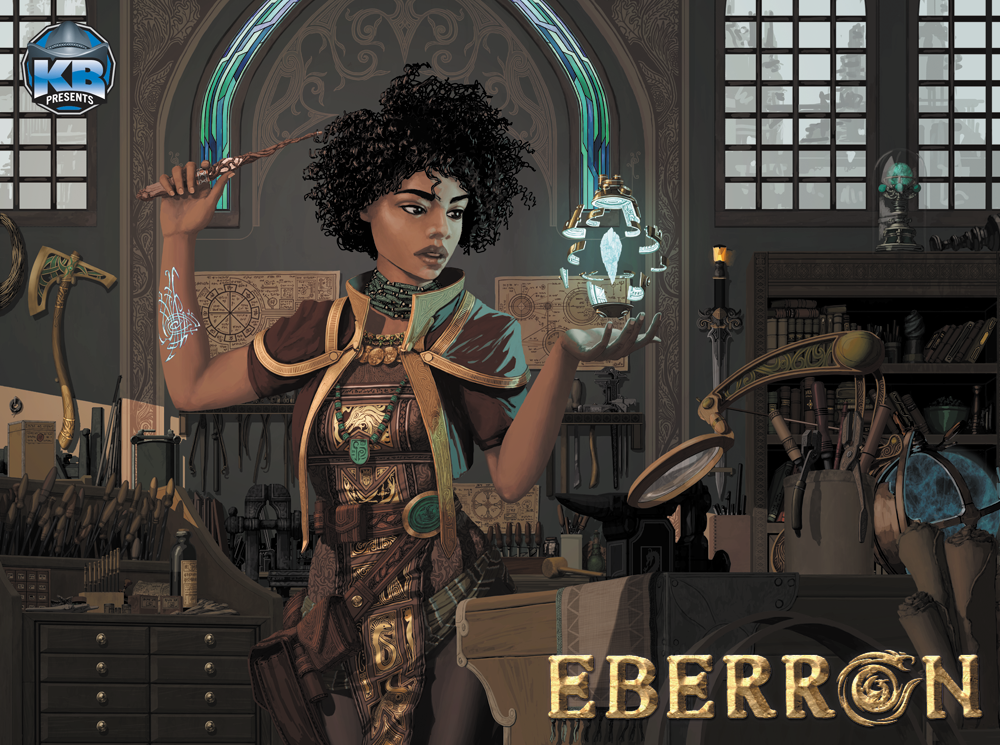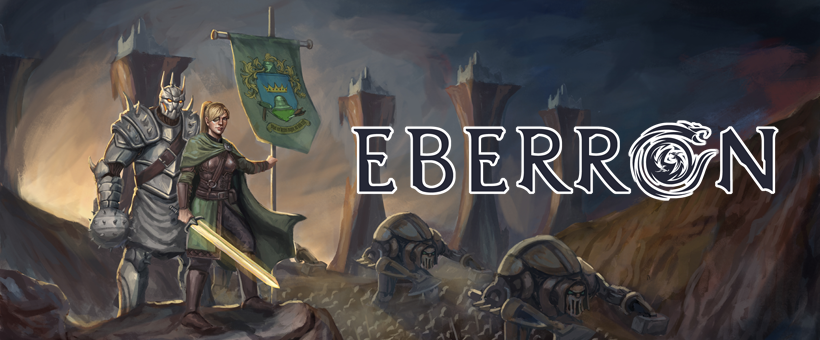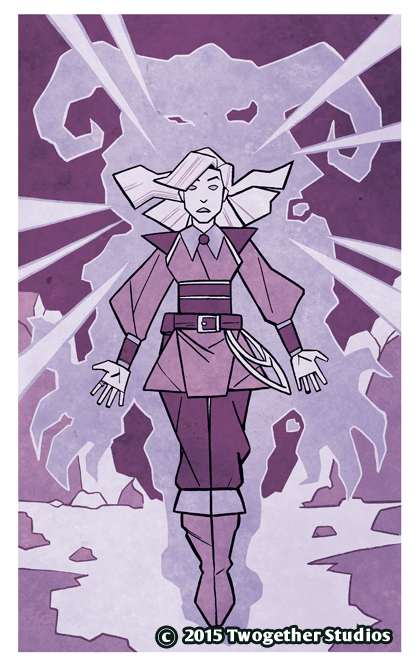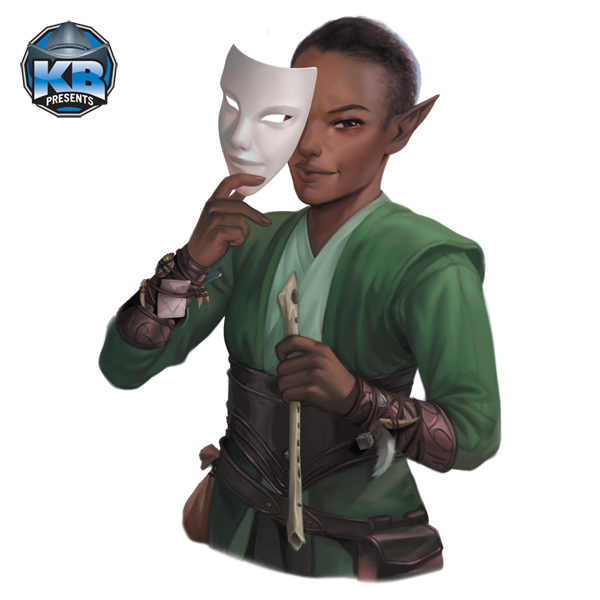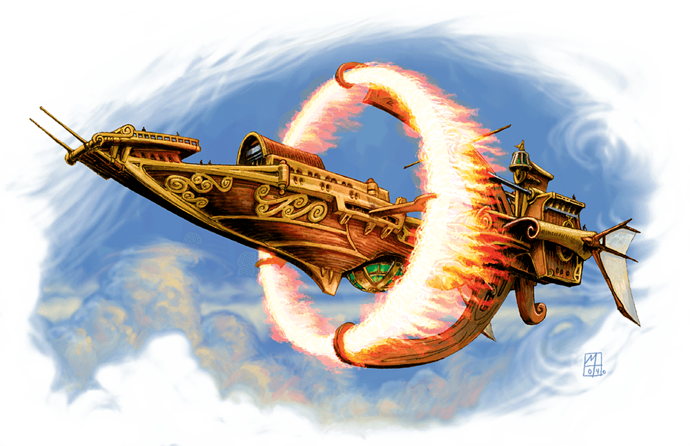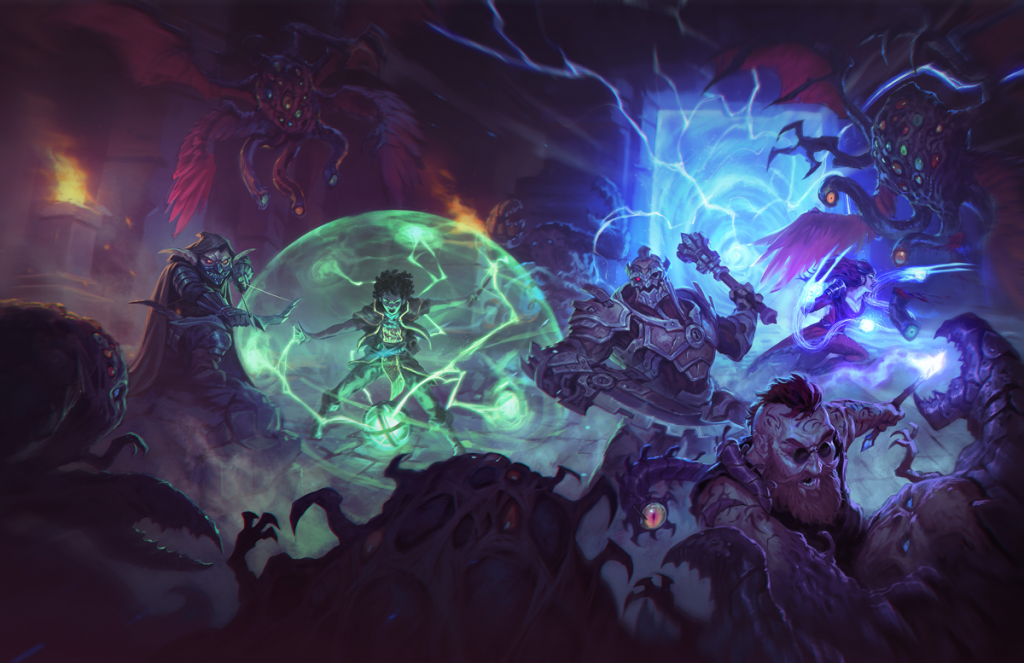
As time permits, I like to answer interesting questions posed by my Patreon supporters. Here’s a few about Dal Quor and its denizens.
Do prophetic dreams occur in Dal Quor and if so do the Dreaming dark collect or research them?
Exploring Eberron has this to say about dreams in Dal Quor:
Dal Quor doesn’t have layers like other planes. Instead, it can be seen as a vast ocean. When a mortal dreams, they fall into that ocean and create an “island”: a dream pocket, shaped by their memories and desires. When they wake, this island disappears. So at any given moment, Dal Quor contains millions of islands, but none last for long.
I’ve bolded the important piece. The key point here is that the quori don’t create or even monitor all mortal dreams. There are far more mortals then there are quori, and at any given time there a hundreds of thousands of dreams that the quori know nothing about. Most dreams are just dreams, shaped by the dreamer’s own memories and mind. Quori CAN interfere with mortal dreams, but so can other creatures—night hags, any creature using the dream spell. Mortal creatures can even create permanent islands, such as the Draconic Eidolon or the Uul Dhakaan.
The point here is that the quori aren’t omniscient or omnipresent within Dal Quor. Other forces can shape dreams, and it’s entirely possible for this to occur without the quori being aware of it. So YES, there can be prophetic dreams in Dal Quor. Such dreams could be actively shaped by powerful beings (again, all it takes is the dream spell). Looking to divine visions, the existence of prophetic dreams doesn’t necessarily prove the existence of the Sovereigns. We know that there is a divine power source that channels power to worshippers of Boldrei. It could be she’s an actual goddess who actively sends a message to her priest; or it could be that “Boldrei” is a spiritual construct that lies within the collective unconscious, and the priest’s dream is drawn from those subconscious depths. Either way, it’s possible to have a vision from Boldrei; but just because you can meet her in your dreams doesn’t mean that she exists in a form you could meet in the flesh.
Does the Dreaming Dark collect or research these dreams? I’m sure it does, IF IT OBSERVES THEM. Again, there are more mortals than quori, and at any given moment a third of the world is asleep; there’s no way for the quori to monitor them all. And personally, I don’t WANT the quori to monitor them all. I like the fact that I can say that the group’s cleric has a divine vision and that the quori don’t know about it. With that said, part of the role of the hashalaq quori is to monitor mortal dreams and dreams and to keep notes. The hashalaq are the loremasters of Dal Quor, and when the Dreaming Dark wants to perform an act of manipulation, it turns to the hashalaq to identify the most effective targets to carry out those goals. So the hashalaq do monitor the dreams fo people the quori have identified as significant, and they maintain a broad “map” of the Ocean of Dreams. Thus, they COULD have observed and recorded any prophetic dream and could well have a vault filled with accounts of thousands of “Dreams of Interest” they’re studying. But it’s ultimately up to the DM to decide if any given dream has been noted and recorded, or if it escaped the many eyes of the Dreaming Dark.
Are there any limits to the Quori ability to shape dreams?
Yes and no. If you’re familiar with Star Trek, think of Dal Quor as a holodeck. Normally, the dreamer shows up and runs their own program. When a creature uses dream, they are overriding that and placing the dreamer in a program of their own design. And that can be ANYTHING. A quori has an even greater degree of control than a wizard using dream. They can control every detail and they’ve had tens of thousands of years to hone their talents at creating dreams.
WITH THAT SAID… This is a game. It’s fun to have adventures in dreams where adventurers can potentially overcome challenges, and with that in mind I wouldn’t want to make quori omnipotent when shaping a dream. So personally, I’d go back to the holodeck analogy. The quori can PROGRAM the dream. They can personally take the place of any creature in the dream, intervening directly. But adventurers can defeat the challenges a quori places in their path. The quori can make you dream about a terrifying dragon, but you and your fellow adventurers could DEFEAT THAT DRAGON; this reflects your will and heroic drive overcoming the quori manipulation.
WITH THAT SAID… That primarily only applies to LUCID dreams. Most dreams don’t get played out as adventures. And with that in mind, that’s why the dream spell has a saving throw! You could look at a successful saving throw as meaning that the caster can’t shape the dream at all; or you could look at it as the caster creating a nightmare but the dreamer defeats the nightmare. So if the quori gives you a dream of a dragon ravaging your village, if you fail your saving throw the dragon destroys your village, kills everyone you love, and then kills you, and you wake up horrified (taking psychic damage and failing the long rest)—while if you MAKE the saving throw, you still dream about a dragon, but in the dream you DEFEAT the dragon. Your subconscious overrides the quori manipulation, and your self-image is so strong that you reject the vision the quori tries to impose.
Do Quori create figments or enlist drifters for the Dreaming Dark?
Let’s look back at Exploring Eberron.
A figment can be anything—a friend of yours, a zombie version of that friend, a demon, a dragon—but the catch is that it’s drawn from the mind of the local dreamer. When you dream about your old drill sergeant, they can’t tell you a secret you don’t already know, because they’re part of you. On the other hand, if you’re in someone else’s dream—or if a quori has taken control of your dream—then the figments can surprise you, because their capabilities and knowledge are drawn from someone else’s mind.
Figments are just part of the basic mechanics of Dal Quor. Any time a dream is created, it’s populated with figments. Look back to the holodeck example: figments are all the NPCs in a holodeck scenario. So yes, the quori create figments that last for the duration of the dream and then dissipate.
DRIFTERS are a different story. Per ExE, “Occasionally, a remarkable figment develops the ability to persist beyond the dream that created it—becoming a truly sentient spirit instead of a simple manifestation… Such free-willed figments are called drifters.” Generally speaking, the Dreaming Dark doesn’t employ drifters and most drifters will do their best to avoid the quori, because DRIFTERS ARE A FLAW IN THE SYSTEM. Why SHOULD a quori deal with a free-willed, unpredictable drifter when it could just use a figment that will do exactly what it’s supposed to do? This is one reason drifters may help adventurers; they themselves aren’t part of the system and have no loyalty to the quori; quori will typically destroy drifters as they ARE flaws in the system. Having said that, it’s possible an unusual drifter could make a deal with the Dreaming Dark and gain greater power through such service. But most drifters won’t take that risk.
The dominator Tirashana is a powerful Inspired mentioned in multiple sources. What kind of quori is she? Sharn: City of Towers doesn’t say, Secrets of Sarlona says she’s usvapna, and the ECG says she’s a kalaraq.
This is what happens when you are dealing with an evolving setting and multiple editions. When Sharn: City of Towers was written, the tsucora quori were the only quori that had been defined. We knew that there WERE others, but we hadn’t solidified any of the details. SECOND: When Tirashana was created, mind seed was a high-level power any psion telepath could potentially manifest. As such, we established Tirashana as a 17th level psion—she had the power to mind seed, but she did it in the same way any other creature could do it, if they happened to be a 17th level telepath.
By the time Secrets of Sarlona came around, we’d introduced more types of quori. The kalaraq quori, in particular, had the innate ability to perform mind seed by binding the essence of a victim. But we’d already defined Tirashana as a 17th-level telepath, so we chose to make her an usvapna—a powerful and respected quori caste, but not kalaraq.
Then fourth edition came around. Fourth edition had no player-facing form of mind seed. We had a version of it associated with the kalaraq, but it was a unique thing. So: the usvapna didn’t exist in fourth edition, and even if they had, we could say Tirashana was an usvapna with enough telepath levels to manifest mind seed, because it didn’t exist in fourth edition. So, in fourth edition we made Tirashana a kalaraq because it meant that DMs would ahve a stat block they could use for her and because it was the only way she could do what she was supposed to do — create mind seeds.
The key point here is that the lore isn’t consistent because the RULES weren’t consistent. We changed the lore to meet the needs of the story. Ultimately, the most important thing was that Tirashana is a quori who can mind seed people. Given that she’s unlikely to ever appear in the flesh, it doesn’t really MATTER is she’s usvapna or kalaraq; what matters most is that she can mind seed people and the DM knows how mind seed works.
So: in fifth edition, I’d personally make Tirashana a kalaraq quori for the same reasons we did it in fourth edition: we have a stat block for kalaraq quori and we don’t have an usvapna block, and a kalaraq quori has a way to plant mind seeds.
In general, however, this ties to the general point that canon isn’t ironclad or infallible, because it wasn’t created in a vacuum. Tirashana couldn’t be an usvapna in the Sharn sourcebook, because usvapna didn’t exist when we wrote it. Canon is a place to start, but it does have contradictions and errors, and it’s up to each DM to decide how to reconcile those in their campaigns.
What are some other types of quori?
I don’t have time to stat out additional quori in this space, but what I will say is that the general idea of quori is that they generally manipulate and feed on certain types of emotion or aspects of the mortal psyche. Tsucora specialize in fear. Du’ulora manipulate rage and hatred. Hashalaq understand pleasure. Kalaraq twist pride and ambition. I didn’t create the tsoreva or usvapna, so they aren’t designed with that in mind; I’d personally probably make the weak tsoreva tied to spite, and the usvapna—described as the judges and inquisitors of Dal Quor—as manipulating concepts of duty and tradition, albeit in the focused path of tyranny and persecution.
With that in mind, what are some other types of quori? I could imagine quori that inspire greed and avarice; quori that sap motivation and thrive on sloth and indolence; quori that thrive on misery; quori that inspire envy. Quori are children of the Dreaming Dark, so they are generally tied to NEGATIVE aspects of the psyche. Kalashtar quori still have this heritage, but turn it around; a tsucora kalashtar understands fear, but can use that knowledge to help people overcome their fears and find their courage.
I don’t understand quori possession. Rising From The Last War says the Quori must be within five feet of the creature it wants to possess, and if it is expelled it appears next to them? I thought quori couldn’t manifest physically?
That’s because quori have access to TWO ENTIRELY DIFFERENT FORMS OF POSSESSION. The form of possession that is presented in the stat block is something the quori can do IF it is physically present. An important detail is that it can use this form of possession on an unwilling target! It would be extremely difficult for a quori TO physically manifest on Eberron—it would involve some sort of unprecedented story hook—but IF IT DID it would be capable of forcibly possessing any humanoid using this technique.
But the catch is that this isn’t the form of possession the Dreaming Dark generally employs, because the quori CAN’T physically manifest in Eberron. So instead, the quori normally possess humanoids through their dreams. The quori crafts a dream (essentially, casting dream) and within that dream, has to convince the target to voluntarily allow the quori to possess them. The victim may not understand exactly what they are agreeing to—the quori could present itself as an angel, as the ghost of an ancestor, etc—but they know that they are agreeing to let an outside spirit temporarily assume control of their body. If they agree, the quori takes possession and maintains control until either it chooses to depart or until it is driven out by magical means; in either case, it returns to Dal Quor. Once the quori leaves, it can’t possess the victim again unless the victim AGREES to the possession again. In some cases, the quori may manage to cultivate its relationship with the victim such that the victim will allow this; again, they may believe the quori to be a guardian angel or an ancestor, as long as the actions the quori takes don’t disprove this. On the other hand, if the quori isn’t trying to maintain a relationship with the host, it may not bother to maintain such a masquerade.
The Inspired are possessed using this second form of possession, but the catch is that each Inspired is bound to a particular quori spirit and they have no choice when that spirit chooses to possess them. However, an Inspired could also voluntarily allow a different quori to possess it, if it served a useful purpose.
This raises a key point, which is that per Rising, forcible possession doesn’t allow the quori to use the proficiencies or class features of the target. The idea of the cooperative possession (or the Inspired) is that the possessed individual DOES have the proficiencies and abilities of both quori and host. This is how the quori can maintain a disguise and why it’s useful to the Inspired quori to have vessels with different skill sets; a particular quori could have one vessel that’s a tough fighter and another that’s a sly assassin, and choose the host that serves its current needs. Likewise, the reason an Inspired might allow a different quori to possess it would be because it needs the particular skills of THAT quori to accomplish its mission. So part of the idea has always been that when dealing with Inspired or with voluntary hosts you’re dealing with a gestalt entity. The quori is in CONTROL, but it gets to draw on the skills and knowledge of its host.
As this second form of possession is different from what’s described in the book, it raises a number of questions. Can a quori possess one of their specially-bred Chosen/Inspired link at any moment, even while that Chosen/Inspired is awake?
Yes, a quori can possess a Chosen vessel at any time. The quori has a direct spiritual connection to its Chosen and this doesn’t require the victim to be asleep.
Does the Protection from Evil and Good spell stop a Chosen/Inspired from being possessed by their linked quori?
An empty vessel who is protected by protection from evil and good can’t be possessed by their quori, and this is something we’ve previously called out as a way that fugitive Chosen could remain free. However, the spell specifies that the target has to be a willing creature, so you couldn’t cast it on an unwilling Inspired to break their connection to their spirit.
Does the Magic Circle spell stop a Chosen/Inspired from being possessed by their linked quori?
If the unpossessed empty vessel is protected by the circle, they can’t be possessed. However, I would again say that this wouldn’t BREAK an existing case of possession; you can’t create a magic circle and then push someone into it to exorcise them. It prevents a possessing spirit from attaching itself to a mortal host, but it doesn’t drive out the spirit once it’s present. At least, that’s the ruling I’d make at MY table (and if your DM disagrees, that’s fine—but this is MY ruling).
Can the Dispel Evil and Good spell drive out a quori from their linked Chosen/Inspired? If so, what stops the quori from immediately repossessing the Chosen/Inspired?
This is addressed in the 3.5 Eberron Campaign Setting entry on Inspired, and the rule seems sound here.
Resist Exorcism: The quori spirit inhabiting an Inspired is subject to a dismissal spell, an exorcism, or a similar effect. Use the total of the human vessel’s character level and the quori’s Hit Dice for the purpose of determining whether the spirit resists dismissal or exorcism. If the effect is successful, the quori spirit is temporarily driven back to Dal Quor. This effect lasts for 10 minutes per caster level of the character who cast the spell or performed the exorcism, after which point the quori spirit can return and possess the human vessel again.
Combining hit dice doesn’t quite work in Fifth Edition, but the point is you can do it but it’s supposed to be hard—I’d probably give the Inspired advantage on their saving throw.
If an Inspired currently possessed by their linked quori is reduced to 0 hit points and knocked unconscious, but not killed, is the quori driven out? Or does the quori stay?
No. The “Brute Force” possession in the quori stat block can be broken by dropping a creature to zero hit points, but rendering a creature unconscious has no effect on either an Inspired or on a creature that has voluntarily allowed a quori to possess it.
Can a possessing quori allow the victim to retain control of their actions—to play the role of an “advising spirit”? Or is it always in full control while possessing a victim?
A possessing quori can always choose not to exercise the full power it has over its victim, but it CAN exercise that full control at any time. So the victim may not REALIZE that they are fully possessed; they may believe it’s some sort of symbiosis or partnership. Which is great, until the quori has a reason to take full control, and which point it will take full control. With that said, the person agreeing to possession is aware that they are allowing possession—that they are allowing the spirit to reside within them. In a situation where the quori doesn’t plan to assume control it may present this as guidance, partnership, etc — but the victim still knows I am allowing a spirit to reside in my body.
How much awareness does a quori have over the status, thoughts, emotions, location, current activities, etc. of its linked Chosen/Inspired, while those Chosen/Inspired are awake and uninhabited?
Very little. For example, we’ve never suggested that if you get into a fight with an empty vessel that its connected quori would somehow be instantly aware of the threat and pop in. Keep in mind that a quori could have HUNDREDS of empty vessels. I’d be inclined to say that the quori would notice the death of a vessel—because it would feel the sudden severing of their link—but even then, if the quori has a lot of vessels I might have them make a Perception check to see if they notice it right away.
When a quori possesses someone, how much access to the host’s memories does the quori have? Does this change based on the possession method: brute force, voluntary possession, linked Chosen/Inspired possession, etc.?
It depends entirely on the form of possession. The brute force possession provides no access to memories whatsoever, which is why the quori “doesn’t gain access to the victim’s knowledge, class features, or proficiencies.” Voluntary possession does grant access to the host’s memories and skills, as specifically called out in the 3.5 ECS: “A possessing quori has immediate access to all of the vessel’s thoughts and memories… The quori spirit combines its skill ranks with those of its vessel.” With that said, while voluntary possession grants full ACCESS to the host’s memories, I’d see this as a human gaining access to a library. You can read any book you want, and when you NEED a specific piece of information you can immediately acquire it, but you most likely don’t have time to read every book in the library. So it’s not like a quori knows every one of your secrets the instant it possesses you; it has to have a reason to dig for a specific piece of information, and it’s quite possible it never bothers to look back to your childhood and find that moment you made a deal with a dragon.
What’s your opinion of the tsoreva and dream master quori from Magic of Eberron? Would you redesign them if you converted them to fifth edition?
I didn’t work on Magic of Eberron. The tsoreva is fine; it’s useful to have a low-CR quori and I can see them as spirits that feed on spite—essentially, lesser tsucora. But I don’t like the dream master. First, it doesn’t follow the naming pattern. We retconned this for Secrets of Sarlona, naming it the usvapna. But beyond that, its basic design doesn’t follow the model used by other quori. The original idea of the quori is that they manipulate and feed upon a particular emotion. This is concretely reflected by their abilities. At a quick glance…
- A tsucora (fear) has Terrifying Sting, which mimics the effects of phantasmal killer, and it regains hit points when it kills someone with this power. When it stings you, it afflicts you with a nightmare so intense it can kill you, and if it does, it feeds on that fear.
- A du’ulora (rage) has Fury Aura—which induces rage in creatures around it—and Burning Rage, which kills a creature with its own anger… and which heals the quori when it kills a creature in this way.
- Hashalaq (pleasure and pain) has Intimate Knowledge (it knows your desires), Empathic Feedback (the attack shares its pain), and Idyllic Touch (which overwhelms with pleasure)… and when it kills a creature with Idyllic Touch, it regains hit points.
The tsoreva is such a minor spirit that it doesn’t have space to follow this pattern. But the dream master is a POWERFUL quori, but it doesn’t have a clear associated emotion or unique powers; it’s a powerful psion, but there’s nothing that reflects a theme. So yes, I might keep the broad concept and form of the usvapna, but if i converted it to 5E I’d want to give it a more defined theme.
That’s all for now! Thanks again to my Patreon supporters for making these articles possible.

 Unlock with Patreon
Unlock with Patreon